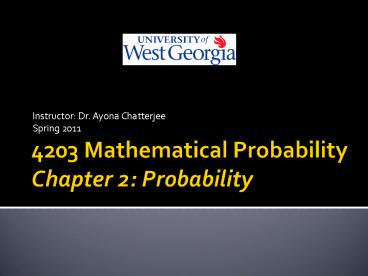4203 Mathematical Probability Chapter 2: Probability - PowerPoint PPT Presentation
1 / 15
Title:
4203 Mathematical Probability Chapter 2: Probability
Description:
Classical Probability concept. If there are N equally likely possibilities of which one must occur and n are regarded as favorable, or as a success, then the ... – PowerPoint PPT presentation
Number of Views:73
Avg rating:3.0/5.0
Title: 4203 Mathematical Probability Chapter 2: Probability
1
4203 Mathematical ProbabilityChapter 2
Probability
- Instructor Dr. Ayona Chatterjee
- Spring 2011
2
Classical Probability concept
- If there are N equally likely possibilities of
which one must occur and n are regarded as
favorable, or as a success, then the probability
of success is given by the ration n/N. - Example Probability of drawing a red card from a
pack of cards 26/52 0.5.
3
Probability
- Measures the likeliness of an outcome of an
experiment. - The probability of an event is the proportion of
the time that events of the same kind will occur
in the long run. - Is a number between 0 and 1, with 0 and 1
included. - Probability of an event A is the ratio of
favorable outcomes to event A to the total
possible outcomes of that experiment.
4
Some Definitions
- An experiment is the process by which an
observation or measurement is made. - When an experiment is preformed it can result in
one or more outcomes which are called events. - A sample space associated with an experiment is
the set containing all possible outcomes of that
experiment. It is denoted by S. - Elements of the sample space are called sample
points.
5
Sample spaces
- Can be
- Finite (toss a coin)
- Countable (toss a coin till the first head
appears) - Discrete (toss a coin)
- Continuous (weight of a coin)
6
Example
- A manufacturer has five seemingly identical
computer terminals available for shipping.
Unknown to her, two of the five are defective. A
particular order calls for two of the terminals
and is filled by randomly selecting two of the
five that are available. - List the sample space for this experiment.
- Let A denote the event that the order is filled
with two nondefective terminals. List the sample
points in A.
7
Venn Diagram
- Graphical representation of sets.
- A is complement of event A.
8
Probability of an Event
- POSTULATE 1 The probability of an event is a
nonnegative real number that is P(A)gt0 for any
subset A of S. - POSTULATE 2 P(S) 1.
- POSTULATE 3 If A1, A2, .is a finite or infinite
sequence of mutually exclusive events of S then
P(A1 U A2 U..)P(A1 )P(A2 )..
9
Mutually exclusive events
- Two events A and B are said to be mutually
exclusive if there are no elements common to the
two sets. The intersection of the two sets is
empty.
10
Rules of Probability
- If A and A are complementary events in a sample
space S, then P(A)1-P(A). Thus P(S) 1. - P(F) 0, probability of an empty set 0.
- If A and B are events in a sample space S and A
is subset B the P(A) lt P(B). - If A and B are any two events in a sample space
then P(A U B) P(A)P(B) P(A B).
11
Conditional Probability
- The conditional probability of an event A, given
that an event B has occurred, is equal to - Provided P(B) gt 0.
- Theorem If A and B are any two events in a
sample space S and P(A)?0, then
12
Independent Events
- Two events A and B are independent if and only if
- If A and B are independent then A and B are also
independent. -
13
Example
- A coin is tossed three times. If A is the event
that a head occurs on each of the first two
tosses, B is the event that a tail occurs on the
thrid toss and C is the event that exactly two
tails occur in the three tosses, show that - Events A and B are independent.
- Events B and C are dependent.
14
Bayes Theorem
- If B1, B2, ., and Bk constitute a partition of
the sample space S and P(Bi) ?0, for i1, 2, .,
k, then for any event A in S such that P(A) ?0
15
Reliability of a product
- The reliability of a product is the probability
that it will function within specified limits for
a specific period of time under specified
environmental conditions. - The reliability of a series system consisting of
n independent components is given by - The reliability of a parallel system consisting
of n independent components is given by - Ri is the reliability of the ith component.































